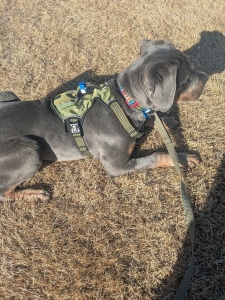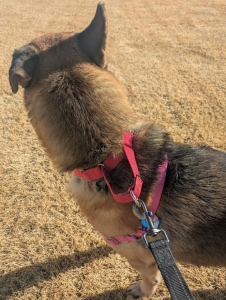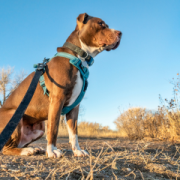April 8, 2025 –
This article was developed by Isaac Cline, Animal Behavior Coordinator, whose expertise and guidance shaped this content.
Using a properly fitted, secure harness and the right leash is essential when walking your dog. The right type of harness offers several benefits: it gives you better control, reduces the risk of injury, and can support your training efforts. While harnesses are often used to manage dogs that pull, they aren’t a quick fix—but they do make it easier to train for long-term success. For the best results, pair your harness with loose-leash walking training. This combination helps create safer, more enjoyable walks—for both you and your dog.
Easy Walk Harness
At NOCO Humane, we recommend a few different harness styles, with one of our top choices being the Easy Walk harness. This is a front-clip harness designed to gently redirect your dog when they pull, encouraging them to face you rather than lunge forward. In general, front-clip harnesses are more effective for managing pulling behavior than back-clip styles, which don’t offer the same redirection. When adjusted correctly, the Easy Walk harness can help prevent pulling and make walks more manageable. It’s especially well-suited for dogs with narrower chests and longer legs—such as retrievers, shepherds, collies, cattle dogs, and similar breeds. Check out this video to learn how to properly fit an Easy Walk harness.

Easy walk harness
No Pull Harness
For dogs that don’t fit well into Easy Walk harnesses, we recommend a style known as a No Pull harness. These vest-style harnesses offer a more secure fit and feature padded panels across the chest and back. This design helps distribute pressure evenly across the dog’s body if they pull, making walks safer and more comfortable. No Pull harnesses are especially helpful for dogs with broader chests and shorter legs—like Staffordshires, pugs, small pit bulls, and English Bulldogs. The wider contact area not only supports better breathing by avoiding concentrated pressure, but also helps prevent dogs from slipping out of the harness. Additionally, vest-style harnesses with a handle on the back can be a great option for dogs with limited mobility, whether due to age, injury, or post-surgery recovery.
This video demonstrates how to properly fit a No Pull harness.

No pull harness
Freedom No Pull Harness
For dogs that tend to pull hard on the leash, we recommend the Freedom No Pull harness. This harness features both front and back leash attachment points and is designed to be used with a double-ended leash. This setup allows you to gently redirect your dog’s attention toward you—making it easier to reinforce training with treats and praise.
When your dog pulls, the back loop tightens slightly, applying gentle pressure across the chest. As soon as your dog stops pulling, the pressure releases—helping them learn that walking calmly results in a more comfortable experience. The loop only tightens to a safe degree, so there’s no risk of applying too much pressure or causing harm.
The unique design positions the tightening loop near the dog’s center of gravity, giving you greater control and even allowing you to gently lift or guide your dog if needed—without causing discomfort. When a dog pulls forward, the harness naturally reduces their leverage by lifting slightly, which helps minimize their pulling strength and gives you more control.
This harness also provides a gentle, hugging sensation around the body, which can be calming for dogs with anxiety or reactivity—similar to the effect of a compression vest. Additionally, the front straps sit below the neck, reducing the risk of neck, trachea, spinal, or eye injuries that can occur with collars or poorly fitted harnesses. The Freedom No Pull harness can also be helpful for dogs with arthritis or amputations, providing added support and comfort.
Check out this video to learn how to properly fit your dog for a Freedom No Pull harness.

Freedom no pull harness
Martingale Collar
A great middle-ground option between a traditional collar and a harness is the martingale collar. Designed with a self-adjusting loop, martingales provide gentle control when a dog pulls—without the bulk of a harness. While not a substitute for a no-pull harness, they’re ideal for dogs that don’t need as much management, such as small breeds, senior dogs who are past their excitable pulling phase, or dogs that don’t fit comfortably into standard harness styles.
Martingale collars work by tightening slightly when tension is applied through the leash, preventing the dog from slipping out. However, they’re designed to stop tightening at a certain point, avoiding the risk of choking or injury. This makes them a safer alternative to traditional choke or slip collars.
The wider the martingale, the better it distributes pressure—helping protect the dog’s trachea and providing a secure fit, especially for breeds with narrower heads or unique body shapes. When properly fitted, a martingale should appear slightly loose, even as if it might slip off. But when the dog pulls, it tightens just enough to stay securely in place without slipping over their head.

Martingale collar
Leash Matters Too
No matter how good the harness is, it won’t help if the leash isn’t up to the job. At NOCO Humane, we recommend using a 6-foot nylon leash or a 6-foot rope leash (½ inch or thicker)—especially for dogs that like to chew. These styles offer strong, reliable connections and help ensure your dog can’t slip away.
Choose the Right Fit and Style
It’s essential to avoid any collar or harness that causes pain or restricts breathing. Pressure on a dog’s trachea from a collar can lead to coughing, choking, or even long-term damage. This is especially important for brachycephalic breeds—like English Bulldogs, French Bulldogs, Pugs, Boston Terriers, and Shih Tzus—who already have difficulty breathing due to their facial structure. These dogs benefit significantly from harnesses that reduce pressure on the neck.
Pulling dogs are also at risk when using collars, as they can unintentionally choke themselves. To protect your dog’s airway, choose a harness that suits their body type and ensures even pressure distribution. Many people opt for Y-front harnesses, like this one from Non-Stop Dogwear, which are designed to avoid putting pressure on the neck.
Why We Recommend Harnesses Over Collars During Walks
Harnesses offer several key advantages over traditional collars, especially when it comes to walking your dog safely and comfortably. Here are some of the top benefits:
- Improved Control
Harnesses give you better control of your dog—particularly helpful in crowded areas, along busy roads, or during high-excitement situations. - Reduces Pulling
Unlike collars, which can reinforce pulling by allowing the dog to move forward, harnesses (especially front-clip styles) redirect movement or lift the dog slightly, discouraging the behavior without causing harm. - Discourages Jumping
For dogs that tend to jump on people, a harness allows you to gently redirect or stop the behavior without the risk of choking or injury to the neck. - Safe & Secure
One major safety advantage of harnesses is that they are less likely to accidentally slip off. Collars can sometimes slip off or unclip when a dog pulls too hard, but a harness fits securely around the body, making accidental escapes far less likely. - Safer for Puppies
Young dogs can easily get tangled or hurt themselves when pulling against a collar. A well-fitted harness provides a safer option for leash training and exploration. - Helps Manage Easily Distracted Dogs
When walking, hiking, or exploring new environments, a harness gives you more control over curious dogs who might bolt after wildlife or get themselves into trouble.
Choosing the right walking equipment for your dog can make all the difference in safety, comfort, and training success—for both of you. If you have questions about harness fit, leash recommendations, or your dog’s behavior on walks, our Behavior Helpline is here to help. Don’t hesitate to reach out—we’re just a call or email away!
Larimer Campus
larimerbehaviorhelp@nocohumane.org
970.226.3647 ext. 5130
Weld Campus
weldbehaviorhelp@nocohumane.org
970.506.9550 ext. 7130




